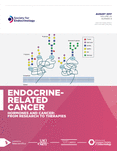Androgen receptor signaling pathways as a target for breast cancer treatment
- Elisabetta Pietri1,
- Vincenza Conteduca1,
- Daniele Andreis2,
- Ilaria Massa2⇑,
- Elisabetta Melegari1,
- Samanta Sarti1,
- Lorenzo Cecconetto1,
- Alessio Schirone1,
- Sara Bravaccini3,
- Patrizia Serra2,
- Anna Fedeli1,
- Roberta Maltoni1,
- Dino Amadori1,
- Ugo De Giorgi1 and
- Andrea Rocca1⇑
- 1Department of Medical Oncology, Istituto Scientifico Romagnolo per lo Studio e la Cura dei Tumori (IRST) IRCCS, Meldola, Forlì-Cesena, Italy
- 2Unit of Biostatistics and Clinical Trials, Istituto Scientifico Romagnolo per lo Studio e la Cura dei Tumori (IRST) IRCCS, Meldola, Forlì-Cesena, Italy
- 3Biosciences Laboratory, Istituto Scientifico Romagnolo per lo Studio e la Cura dei Tumori (IRST) IRCCS, Meldola, Forlì-Cesena, Italy
- Correspondence should be addressed to I Massa or A Rocca; Email: ilaria.massa{at}irst.emr.it or andrea.rocca{at}irst.emr.it
-
Figure 1
ERK-mediated non-transcriptional/non-genomic AR signaling. (1) Left, cytoplasmic AR interacts with phosphoinositide 3-kinase (PI3K), Src family kinase and Ras GTPase, which in turn converge on MAPK/ERK pathway with subsequent ERK translocation into the nucleus and induction of genes involved in cell proliferation. (2) Right, membrane-bound AR or plasma membrane G protein-coupled receptors (GPCRs) or sex hormone-binding globulin receptor (SHBGR) upregulates cyclic adenosine monophosphate (cAMP) levels, modulating Ca2+ intracellular concentration activating protein kinase C (PKC), which converges on the MAPK/ERK pathway.
-
Figure 2
Non-ERK-mediated non-transcriptional/non-genomic AR signaling. (1) Left, cytoplasmic AR/PI3K interaction induces mammalian target of rapamycin (mTOR) phosphorylation (and consequent activation) and forkhead box protein O1 (FOXO1) phosphorylation (and consequent inactivation). A direct interaction of cytoplasmic AR with FOXO1 also induces its phosphorylation and consequent inactivation. (2) Right, membrane-bound AR/GPCRs/SHBGR, through Ca2+ intracellular concentration modulation, activate protein kinase A (PKA). Activated mTOR and PKA and inactivated FOXO1 lead to increased cell proliferation.
-
Figure 4
AR signaling effects in breast cancer subtypes. (A) ER-positive/AR-positive breast cancer: (1) AR directly inhibits ER target genes. (2) AR competes with ER for binding on ERE. (3) AR binds and sequesters TF. (4) AR upregulates ERβ receptors. (5) AR induces direct downregulation of cyclin D1 gene expression. (B) TN/LAR BC: AR drives tumor progression. (C) ERneg/HER2pos/ARpos BC: (1) AR directly upregulates WNT7B, which acts on WNT/β-CATENIN, stimulating HER3 gene transcription with subsequent HER3/HER2 heterodimerization and modulation of PI3K/AKT pathway. (2) HER2/HER3 heterodimers activate PI3K/AKT pathway, which phosphorylates MAD1, promoting its degradation and dissociation from Max with subsequent MYC-MAX heterodimerization and access to transcriptional sites. (3) AR induces dissociation of repressor transcription factor 7-like 2 (TCF7L2) from the pioneer transcription factor of AR, FOXA1, promoting AR target gene MYC transcription. (4) AR induces ErbB2 expression, which activates ERK with consequent cell proliferative effect.
- © 2016 Society for Endocrinology












